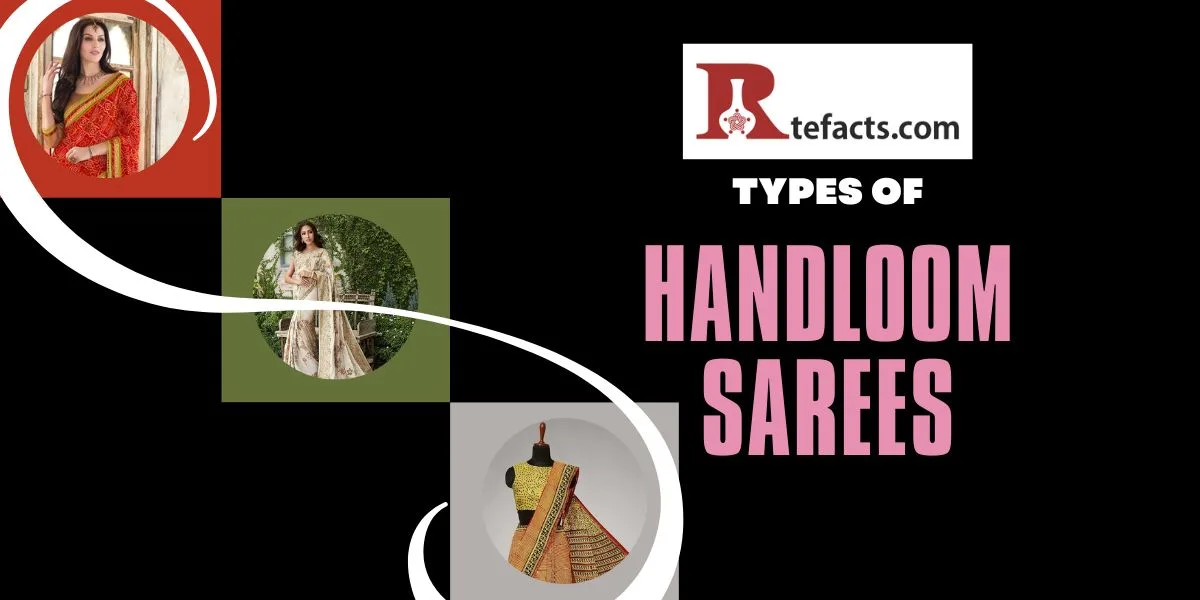Types of Handloom Sarees
Saree is an integral part of Indian culture and the most popular Indian attire worn by women living in India.
Be it a simple plain saree or an imperial handloom saree, the love for this ethnic garb among Indian women grows manifold. Pure Indian handloom fabrics are known for their classic material and elegant designs.
The handloom sarees produced in each Indian region are distinctive and represent the region’s rich culture, history, and tradition.
In this article, we have a closer look at handloom sarees’ many types and features.
- What is Handloom Fabric?
- Handloom Sarees Types Every Woman Should Own
- Types of Work on Saree
- Conclusion
What is Handloom Fabric?
Handloom fabric is a textile woven by hand on a loom, as opposed to being manufactured using an automated machine. The weaving process involves intersecting a set of vertical thread groups (the warp) with a bunch of horizontal threads (the weft).
Handloom fabrics can be made from various fibres, such as silk, cotton, wool and linen. These fabrics are highly valued due to their unique textures, patterns, and colours and their cultural and historical significance.
Artisans typically use all-natural materials to make these sarees and rarely use synthetic materials. As a result, the colours are derived from natural dyes and are long-lasting.
Though power looms are widely used today, handlooms are still relevant, and modern-day women love the latest handloom sarees as they are sustainable and environmentally friendly.
Handloom Sarees Types Every Woman Should Own
In India, you will find different sarees from other states. The wide range of handloom sarees includes formal events like Benarasi or Kanjeevaram and those for daily wear like Chanderi or Begumpuri.
Before we delve into the details, have a look at the following table, which features the names of different handloom sarees that are popular in various states in India.
| Handloom Saree Type | State |
|---|---|
| Bandhani saree | Gujarat and Rajasthan |
| Banarasi saree | Uttar Pradesh |
| Chanderi saree | Madhya Pradesh |
| Kanjeevaram saree | Tamil Nadu |
| Bomkai saree | Orissa |
| Begumpuri saree | West Bengal |
Bandhani Saree
Gujarat and Rajasthan are known for their finest trendy collection of Bandhani sarees. Bandhani sarees involve tying small portions of the fabric regularly to create intricate designs.
These sarees are popularly known for their vibrant colours, intricate designs and quality. The higher the number of dots in a detailed plan, the costlier the Bandhani saree.
Banarasi Saree
Banarasi sarees from Varanasi are known for their elegance and beauty. It is one of the most sought-after types of sarees, and women frequently wear them on occasions like weddings because of its exquisite designs and gold and silver zari patterns.
The saree designs typically feature leaves, gold weavings, figures with small details, metallic visual effects etc.
Chanderi Saree
Chanderi sarees are crafted from quality cotton, zari, and pure silk. It is known for its sheer texture and glossy transparency, one of the lightest saree in India. These sarees are better for summer because they are lighter and less expensive than others.
These stunning sarees are imprinted with common patterns and designs drawn from nature, such as trees, fruits, flowers, swans, peacocks, geometric shapes, celestial bodies, gold coins, and images of animals to attract the viewers’ senses.
Kanjeevaram Saree
The classic Kanjivaram, or Kanchipuram silk saree from Tamil Nadu, is another popular handloom saree. These sarees come in sophisticated patterns and striking colour contrasts and feature royal texture and glossy temperament.
It is impressive how separately woven the pallu, body, and border are on Kanjeevaram sarees before being stitched together. The edges of Kanjeevaram sarees contrast, which makes them easily recognizable.
Bomkai Saree
The ethnic Bomkai sarees draw rich designs and motifs from tribal art and natural surroundings. The tortoise, ancient fish, lotus, peacock, and bird interweaved motifs on red, white, and black coloured backgrounds are what distinguish the Bomkai sarees from the rest.
Artisans create patterns on Bomkai sarees using the Jala technique.
Begumpuri Saree
Because they are light and airy, Begumpuri sarees are perfect for informal events, and women can consider them as an outfit for the workplace.
Their straightforward body and contrasted border make them a good choice for summer.
Types of Work on Saree
Different types of work can be applied to sarees to give them a beautiful and unique look. Here are some of the most prevalent works on sarees:
- Embroidery work: It is the craft of using a needle and thread to decorate fabric. Embroidery can produce various motifs and patterns, whether done manually or mechanically.
- Zari work: A delicate gold or silver wire is used to create the thread known as zari. Designers use it to add a touch of luxury and elegance to sarees.
- Mirror work: Mirror work is a style of hand needlework that involves stitching tiny mirror pieces on the fabric. It is also known as Sheesha and Abhala Bharat embroidery.
- Print work: Print work involves printing a design on the fabric using dye or ink. It creates various patterns and designs, providing sarees with an attractive appearance.
- Stonework: Stonework embroidery refers to using various coloured stones to adorn the garment and enhance the existing embroidery patterns.
Conclusion
To sum up, there are various types of handloom sarees you can go for depending on the occasion. For instance, if it is a wedding or formal function, Banarasi or Kanjeevaram sarees will be a good choice.
On the other hand, if you are looking for a comfortable saree for daily wear, a Chanderi or handloom cotton saree is a great alternative, as they are lightweight and easy to drape.
What is handloom cotton?
All handloom cotton is a handloom fabric, meaning handloom cotton precisely refers to cotton fabric woven on a handloom. Cotton is a fabric derived from cotton plants.
What is the difference between handloom and power loom sarees?
Handloom sarees are handwoven with a traditional look, whereas power loom sarees are made using automated machines.


Leave a Reply